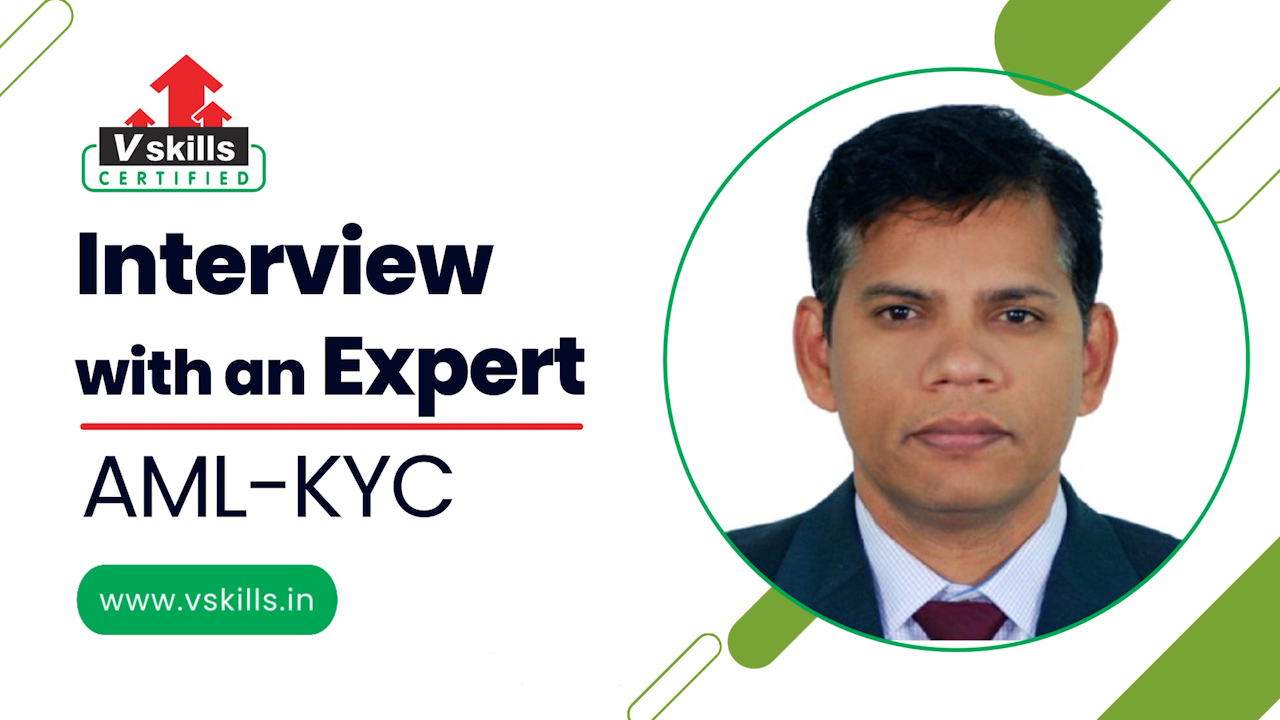Anti-money laundering (AML) primarily focuses on activities financial institutions perform for achieving compliance with legal requirements for actively monitoring and reporting any kind of suspicious activities. On the other hand, Know Your Customer (KYC) indicates customer identification and screening to understand their risk to your business. Let’s now look at some of the key skills to become an AML/KYC compliance Officer.
Why do you need to learn for becoming an AML/KYC Compliance Officer?
As an AML Compliance Officer, you will be in charge of handling financial regulations and managing data compliance requirements. Also, you will be responsible to ensure that the organisation’s AML policy is in accordance with the international system. Some of the other roles and responsibilities include payment fraud prevention, sanction screening, transaction monitoring for fiat and cryptocurrency, also –
- Examining records of high risk clients and reporting any kind of suspicious activities
- Administering and implementing Money Laundering programs
- Conducting inspections from third-party organizations and rectifying any issues
We now look at some of the interview questions that will get you that dream-salary-job.
Let’s now listen to the leading industry expert Mr. Vishwanath Chaganti. He is having 10 years of experience in AML Transaction Monitoring/ Sanctions Screening/Name and Transaction Screening/KYC Due Diligence/Financial Crime Compliance. Key specialities include – Financial Crime Compliance, AML/KYC Operations, Fraud Examination, Sanction Screening, Transaction Monitoring and Compliance functions
Q1. What interested you in getting into the field of AML-KYC?
The auditing and accounting skill set that I have acquired during my tenure in accounting jobs for 14 years in multiple industries and as an articled student of ICAI, helped me to get into the AML department at HSBC.
Q2.AML-KYC is currently confronting immense change in terms of digitization and evolving customer expectations. This brings both risk and opportunity. What’s your opinion about it?
Digitization of AML-KYC gives a better customer experience with accuracy in capturing the customer information quickly and efficiently, saving the customer’s time during the process of onboarding. This enables organizations to improve their customer base and increase in the volume of transactions which in turn contributes to increasing the bottom line.
At the same time, the risk involved in the digital onboarding of a customer comes from relying on the
- non-face-to-face communication,
- the authenticity of the documents uploaded
- possibility of morphed images, tampered documents
However, with appropriate and relevant regulations by the regulators and by using the relevant technology vendors for identification and verification of customers and authentication software to verify the documents submitted, most of the risks posed above can be mitigated by the Compliance departments with the right skill and experienced staff.
Many of the countries in the middle east and elsewhere in the World are providing access to National e-KYC systems whereby the Financial Institutions and regulated entities by becoming members of the National eKYC system are able to complete their digital onboarding of the customer with much comfort and speed.
Q3. Have AML-KYC regulations increased the compliance burden for the companies globally?
In my opinion, in reality, the AML-KYC regulations decreased the compliance burden for the companies globally, why because the digitization process of onboarding a customer reduces the turnaround time and manual intervention and it is advantageous due to the accuracy and effectiveness of capturing the data and this reduces the manual errors in the process.
Do you think Digitalization is a prerequisite for success in this sector?
In the current pandemic situation, in my opinion, yes. The Financial Institutions or Regulated entities’ compliance departments are facing a challenge in onboarding the customers from locally and internationally since the COVID pandemic started across the world.
The biggest challenge is to comply with the Country’s COVID precautions and protocols by the individuals making customers avoid face-to-face, physical contact or following social distance contributed to implementing digital onboarding of the customers where customers can open the accounts from their place by using the mobile phone/laptop or desktop with ease. This becomes easy for the customers to get their accounts opened quickly and faster which helped FIs to increase their customer base hence digitization became a prerequisite for FIs to become successful.
Further, the technological innovation in the Fintech industry such as Open Banking, and API integration with payment networks made it a prerequisite for the FIs to become successful.
Q4.How does the AML/KYC team manage to be updated on the PEP list?
In my experience, the PEP lists will be managed by subscribing to a reliable PEP list provider such as Dow Jones, World-Check etc. Therefore, identifying a PEP is a necessary step in KYC to classify the risk category of the customer based on which the due diligence measures will vary. AML-KYC team to have oversight on the results of the lists by testing at regular intervals to see that these private vendor resources are providing the up-to-date PEP lists of the locations in which the FIs operate to identify the PEPs involved in their customer onboarding process.
Hence, involvement of a PEP is a High risk, senior management approval is required before onboarding the customer, hence identifying a PEP from reliable sources is
Q5.What is the biggest challenge for discovering and reporting money laundering and fraud in financial institutions?
The biggest challenge in my opinion is the collection and extraction of transaction data of a customer by the technology team. Next comes the quality of the data extracted/collected and then the skillset of analyzing the customer data and defining the scenarios and thresholds, and data model validation for monitoring to identify the ML and Fraud patterns.
Q6.What are the key technologies or tools are essential for the AML-KYC department?
Technologies such as either in-house developed or outsourced vendor systems for Sanctions Screening, AML Transaction Monitoring, and KYC & CDD are essential for the AML-KYC department.
Examples: World Check, SAS, Sumsub, Jumio, SIRON etc;
Q7.How Bitcoin is being treated under AML-KYC regulations?
To my understanding, Bitcoin is part of Crypto assets or virtual assets. Entities involved in virtual asset activities or Virtual asset service providers should apply preventive measures described in FATF recommendations from 10 to 21.
FATF Travel Rule requires Virtual Asset Service Providers (VASPs) such as cryptocurrency exchanges, digital wallet providers and even some financial institutions including banks dealing with crypto assets, to ensure that certain customer data is disclosed and transferred between counterparties as a part of the cryptocurrency transaction
There are several regulatory requirements in different countries with regard to Crypto assets. As this is an evolving industry, there is a lot of work to be done by Regulators across the World to come up with a unified regulatory requirement. Currently, multiple countries are working on developing the regulatory requirements for Cryptocurrency exchanges. In the middle east, UAE & Bahrain already have their own regulations on Crypto assets.
Q8.What tools are used for transaction monitoring to raise red flags more effectively?
Know your customer, Ongoing Due Diligence and customer transaction behaviour analysis are the key measures to use to identify the red flags based on the customer profile and industry.
There are several software tools available in the market which are developed using Artificial Intelligence and Machine learning to analyse the data and patterns of customer transactions. Some of the popular tools are SAS, FICO Tonebeller, Actimize
Q9. What are the factors to perform successful AML transaction monitoring?
Some of the factors are as below –
- Establishing customer identification & purpose of a transaction,
- Risk assessment of the customers based on the Country risk, product risk, Customer risk and delivery channel risk.
- Risk categorization of customers to assess the level of monitoring to conduct.
- Employee training on the latest trends, typologies, and red flags of ML.
Q10. What is a Sanctions Screening Programme and why do you need it?
A sanctions screening program is a program that consists of screening the customers, third parties, products and transactions against domestic and international watch lists/black lists to manage the Sanctions risk by a Financial Institution. This is required for FIs to prevent themselves to avoid any regulatory penalties, and reputational risks and to make sure that their financial systems are not used by Sanctioned persons/entities. According to OFAC, the five essential components of the sanctions Screening program –
- Management commitment;
- Risk assessment;
- Internal controls;
- Testing and auditing;
- Training.
Q11. How to ensure that the technology supports an effective Sanctions Screening Programme?
To ensure that the technology supports an effective sanctions screening program, the technology used in this program is to be tested for all possible false positives before implementing the screening. Further, the results of the screening depend on the data fed into the sanctions screening tool. Hence, the AML department needs to coordinate with IT Team and provide their inputs to derive the best results of the sanctions screening technology used in the company.
Subject Matter Experts in AML/Sanctions to discuss with IT department staff defining the logic to be implemented in the sanctions screening to give optimal quality alerts and to reduce the % of false positives and weak alerts by defining the algorithms, fuzzy logics (Levenshtein, phonetic & Equivalence and Non-equivalence) and appropriate sanctions screening rules.
Therefore, the system needs to be tested regularly and AML/KYC department should have oversight of the watchlist feeds and their updating in the system.
Q12. What factors impact an individual’s or company’s risk profile so as to be under EDD?
Classifying a customer under EDD is based on the FIs risk appetite. However, some of the factors that impact the risk profile of a customer are –
- Non-face-to-face onboarding (Digital onboarding)
- Non-resident customers
- Entities with complex structures were identifying the Ultimate Beneficial Owner is difficult
- Entities structures involve multiple layers with holding companies as beneficial owners
- Customers residing or operating in High-risk jurisdictions, with weak AML/CFT measures,
- Customers who are highly vulnerable to account takeover fraud or can be used as smurfs in ML process (such as senior citizens, students, unemployed, housewives)
- The product or service offered to the customer by FI
Q13. Which skills and qualifications are essential to enter the AML/KYC?
- Certifications and qualifications in AML – KYC obtained from renowned international training institutions such as Vskills, ACAMS, ICA.
- Keeping updated with the latest industry trends in AML/KYC.
- Attending webinars/training on AML/KYC and networking with peers and seniors.
- Eye for detail, analytical and research skills, Narrative writing skills, and Critical thinking skills.
- Knowledge of various industries and their vulnerabilities to ML.
Q16. What according to you are the common mistakes committed by new entrants in AML-KYC operations?
From my experience, some of the common mistakes committed by new entrants in AML-KYC operations are –
- Not knowing where and when to stop the research
- Discounting potential matches as false positives with the limited information rather than escalating to the next level for further investigation.
- Incorrect or Insufficient narratives or conclusions on the decision made to close or escalate an alert.
- Missing to attach relevant research documents to the case
- Ignoring the feedback received from the QA team on the previously worked alerts.
- Distracting themselves in research on the internet for irrelevant or unnecessary information
- Nonadherence to the process or policy on AML/CFT procedures.
Q18. What is your advice for people who are looking at building a career in this field?
Identify your strengths in AML/KYC domain and see in which area you want to build your careers such as –
- AML Compliance Technology or
- Training & Development or
- AML Operations or
- Advisor/consultant
- Regulatory Compliance etc;
There are multiple opportunities available in this field as said above and one should opt for one of the above paths and become an expert in that area. This will give a long-term benefit in the career.
- Look out for the opportunities to learn and grow always.
- Keep updated with the latest trends, typologies, and regulatory requirements of AML/KYC/Sanctions.
- Read the white papers, case studies, and articles from professional training institutions.
- Acquaint yourself with the local and internal AML/KYC regulatory requirements relevant to your Company operations.
- Keep building a good professional network with AML/KYC experts who are already working in Financial Institutions and other industries.
- Regular conversation with them will give a lot of insights to work on developing the career.




